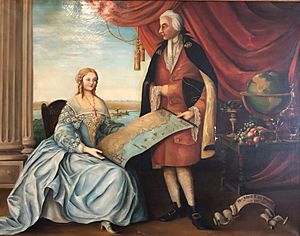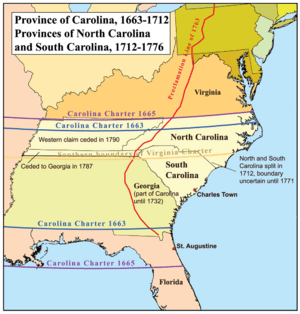John Yeamans facts for kids
Quick facts for kids
Sir John Yeamans
|
|
|---|---|

A portrait of Yeamans and his wife
|
|
| Governor of Carolina | |
| In office 19 April 1672 – 13 August 1674 |
|
| Monarch | James II & VII |
| Preceded by | Joseph West |
| Succeeded by | Joseph West |
| Personal details | |
| Born | 28 February 1611 Bristol, England |
| Died | August 1674 Carolina, English America |
| Spouses | Limp Margaret Berringer |
| Occupation | colonial administrator |
Sir John Yeamans, 1st Baronet (born 1611–died 1674) was an important English leader. He helped manage colonies for England. From 1672 to 1674, he served as the Governor of Carolina. He was also a planter, meaning he owned and managed large farms.
Contents
Early Life and Career
Sir John Yeamans was born in Bristol, England, and was baptized on February 28, 1611. His father, also named John Yeamans, was a brewer. A brewer makes beer.
During the English Civil War, John Yeamans was a colonel. He fought for the Royalist army. This army supported the King of England.
Around 1650, Yeamans moved to Barbados. Barbados is an island in the Caribbean. He quickly became a very successful landowner there. He had owned land in Barbados since 1638. Within ten years, he was a colonel in the local army. He also became a judge and served on the Barbadian council.
Adventures in Carolina
In the 1660s and 1670s, many planters in Barbados looked for new chances. The economy was not doing well. In 1663, some Barbadian planters made a deal. They worked with the owners of Carolina to start a new colony. This new colony was planned at Cape Fear.
The Lords Proprietors were the owners of Carolina. They helped Yeamans become a baronet. This was a special title given by the King. He received this title on January 12, 1665. On January 11, 1665, they made him governor of the new colony. His area of control stretched from Cape Fear to San Mateo.
This area was called Clarendon County. Yeamans was also told to explore the coast south of Cape Fear. He sailed from Barbados in January 1665 with three ships. They reached Cape Fear, but the journey was difficult. They faced bad weather and lost many things.
Because of this, Yeamans soon went back to Barbados. He left Captain Robert Sandford in charge of the new settlement. But the colonists left Clarendon by the end of 1667.
A New Attempt at Colonization
In 1669, another try at starting a colony was made. Three ships full of settlers sailed from the British Isles. They were going to Port Royal Island. First, they stopped in Barbados. The owners of Carolina told Yeamans to name a governor. Yeamans chose himself. He joined the trip until it reached Bermuda.
In Bermuda, he changed his mind. He appointed an older man named William Sayle in his place. Then, he quickly returned to Barbados. The expedition continued without him. In April 1670, they successfully started South Carolina's first lasting English settlement.
Becoming Governor
Governor Sayle died in March 1671. Before he passed away, he chose Joseph West to take his place. The colonists agreed with this choice. Yeamans arrived in the new colony in 1671. He was disappointed that he was not made governor right away.
He became the speaker of the colony's first parliament. He used this position to cause problems for West. He also began to build a large farm. He brought 200 enslaved African people to work on his plantation.
On August 21, 1671, the owners of Carolina made a decision. They appointed Yeamans as the governor. This made many colonists unhappy. He was officially announced as Governor of the English Province of Carolina in Charles Town on April 19, 1672.
Early in his time as governor, he followed the owners' request. He started a land survey for what would become Charles Town. He also made his own plantation even bigger.
Challenges as Governor
During his time as governor, the colony faced many problems. There were disagreements among the colonists. They also felt threatened by the Spanish and the Native Americans. The owners of Carolina were not happy with Yeamans. They thought he spent too much money. They also felt he did not care enough about their interests.
The colonists had their own complaints. They did not like that he made money by selling food from Barbados. In May 1674, the owners decided to replace Yeamans. They chose Joseph West, who had been governor before. However, Yeamans likely died before he received this news.
Records from the colony's Grand Council show that Yeamans led a meeting as governor on August 3, 1674. But the records for the next meeting, on August 13, 1674, say that Yeamans had died.
Yeamans Family Life
Sir John Yeamans was married two times. His first wife was named Limp. They had five sons together. His second marriage was on April 11, 1661, to Margaret Berringer. They had four children, two sons and two daughters.
Sir John's wealth in Barbados went to his son, Major Sir William Yeamans. William was the second baronet. His great-grandson, Sir John Yeamans of Barbados, had a son named Sir Robert. Sir Robert (who died in 1788) was the last baronet in this line.
The Yeamans Hall mansion in Goose Creek, near Charleston, still remembers Yeamans' connection to the colony.
Lieutenant Colonel Josiah Martin was the last colonial governor of the Province of North Carolina. He was also part of the same Yeamans family from the West Indies.
The Yeamans family was large and often important in Bristol, England. Some members later became Quakers. One famous member was Robert Yeamans, a sheriff of Bristol. He was not a close relative of Sir John.


